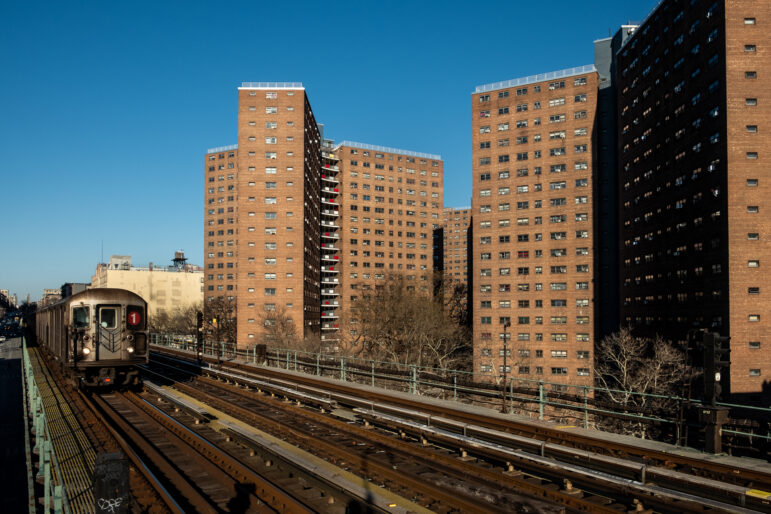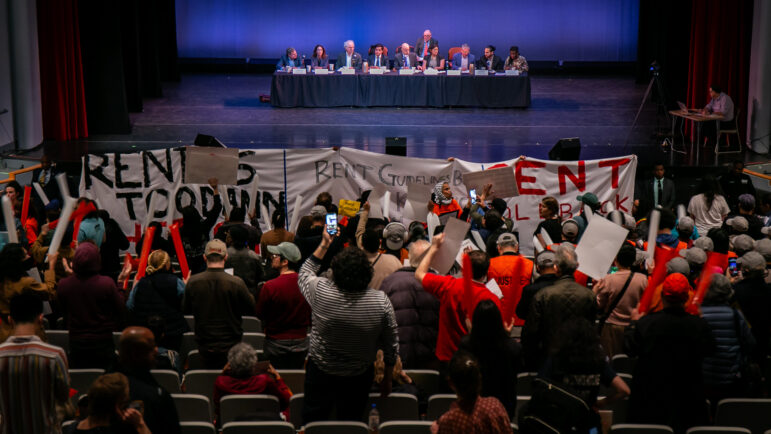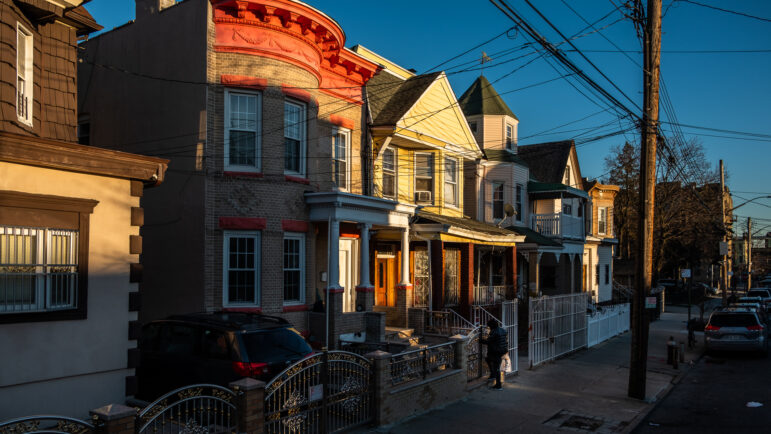More than 36,000 NYCHA apartments have either undergone conversion or are in the process of being converted to the RAD-PACT program, which officials say has helped drive billions in needed repairs. But tenants—some of whom will get a chance to vote this year on whether they want their developments to join the initiative—remain distrustful of the change.

Adi Talwar
NYCHA’s Manhattanville Houses in Harlem will receive $222 million in repairs through the Permanent Affordability Commitment Together (PACT) program.Marveling at the view of LaGuardia Airport from her 18th floor apartment window is one of the lone constants for Brenda Williams after six decades of living in Manhattanville Houses, where she’s witnessed a series of evolutionary changes at the West Harlem NYCHA development.
Soon, Williams and her neighbors will witness yet another phase of life at Manhattanville.
NYCHA announced late last month that the housing development, consisting of six buildings, will receive $222 million worth of much-needed repairs to its units and outdoor spaces through the Permanent Affordability Commitment Together (PACT) program, a local version of the federal government’s Rental Assistance Demonstration (RAD) initiative. Two private developers, Apex Building Group and Gilbane Development Company, will take the reins during the construction stage and thereafter.
Once the developers break ground in the summer of 2024, apartments will have new windows, flooring and added security systems to its buildings, officials said. Outside, there will be touched up garden spaces, polished seating areas and a new and improved ball field.
The slated plans resemble the “fantastic environment” Williams said she remembers when growing up in Manhattanville. In its heyday, she said, there were swift maintenance repairs, grass mowed on a frequent basis and an exposed terrace colored with vibrant red, blue, yellow and white tiling.
At present, the development is facing a backlog of repair tickets—with more than 6,600 open work orders as of February—unkempt green spaces and worn out paint on the metal squares of the terrace. “I used to have a view of Jersey but that’s been blocked off by new buildings—a lot of that view is gone,” Williams said.
What is also out of plain sight to Williams is the future of Manhattanville Houses, one of 36 public housing developments in the city either in the planning or construction phase of a RAD-PACT conversion, through which properties’ operations are turned over to private companies, allowing NYCHA to tap into additional funding it can’t access under the traditional public housing model.
RAD-PACT is one of two main funding mechanisms NYCHA officials are pitching to address $40 billion in dire repairs across the system caused by decades of mismanagement and underfunding. The other option, called the Preservation Trust, is part of an initiative called Blueprint for Change through which participating NYCHA campuses would be managed by a public benefit corporation created by the state last year.
Both initiatives would convert Section 9 public housing developments to a Section 8 subsidy, which is worth nearly twice as much.
This year, NYCHA tenants at select developments will for the first time get to choose which of those funding models they want for their homes, or they can opt to reject both options and remain in Section 9, what officials refer to as the “status quo.”
The voting process is likely to be divisive, as many residents remain deeply skeptical of efforts to involve private entities in public housing management, including tenants like Williams who worry the shift could fuel rent increases and evictions.
“They say change is good, but not all the time,” said Williams.
Rebuilding trust
NYCHA said it would start the voting process early this year, though has yet to publicly announce specifics. News site THE CITY reported last month that the housing authority is behind schedule on its plans for the Preservation Trust—to which NYCHA wants to transfer some 110,000 units to fund repairs—having yet to appoint any board members to run the newly-created entity in the wake of former NYCHA CEO and Chair Greg Russ’ resignation earlier this year.
RAD-PACT conversions, however, are moving full steam ahead. The program intends to convert 62,000 units to these public-private partnerships by 2028, in which NYCHA will continue to own the developments while granting a 99-year lease to private companies or nonprofits put in charge of repairs and daily operations.
Since launching in 2016, NYCHA is more than halfway to that goal: In January, Mayor Adams announced that 36,103 apartments across 137 developments have either already undergone conversion or are in the process. Last year alone, RAD-PACT projects accounted for $2 billion in renovations for more than 8,500 apartments in 17 developments, officials said.
Residents in existing RAD-PACT developments did not have the option to choose or decline the initiative. Tenants, however, were able to select the private developer and come up with a list of enhancements they would like to see for their homes.
At Manhattanville, residents discussed priorities with potential development teams starting in the summer of 2021. Ultimately, Apex Building Group, Gilbane Development Company and the West Harlem Group Assistance were the winning team selected to turn their visions into reality.
NYCHA Executive Vice President of Real Estate Development Jonathan Gouvia in a statement said the PACT partner designation is an important step towards addressing the repair needs that have affected the quality of life of tenants for many years. “The result is a partnership that will yield drastic improvements in the day-to-day lives of NYCHA residents,” Gouvia said.
The process between the planning phase to completion takes an estimated two years, according to NYCHA. In the early stages, developers have conversations with residents about their apprehensions and their hopes for the coming years. Some residents are even taken on a bus ride to tour developments that have already undergone conversion.
For Williams, the trip was from Manhattanville Houses to Murphy Houses in the Northeast Bronx, where major RAD-PACT rehabilitation projects were completed in 2021. “I was not impressed by the things they did,” Williams said. “They had more mailboxes broken into than I had.”
Private developers involved in RAD-PACT efforts told City Limits they’re aware that restoring mismanaged buildings to good condition, and mending broken trust with tenants, are not tasks that can be done overnight. NYCHA residents are rightly skeptical, having for years endured problems like chronically broken elevators, lead paint poisoning and questions about whether their cloudy tap water was safe to drink.
“I think we knew walking into a project like this that there are folks who are being overlooked but we did not realize the extent of it,” said Amy Stokes, vice president at Monadnock Development LLC.
Stokes is a partner in the PACT Renaissance Collaborative, which helps manage 1,718 NYCHA apartments under RAD-PACT, including at Manhattanville Houses, part of a project known as the “the Manhattan bundle.” When knocking on doors to make assessments, they saw units without ceilings or sinks, she said.
“Nothing is ever going to be perfect; this is a controversial program,” Stokes acknowledged. “We can’t deny that this is a private entity getting involved in a public resource.”
Building trust with residents who have been disappointed by earlier promises and mismanagement is a priority for her and her colleague, Pierre Downing, another PACT Renaissance Collaborative partner and the founder and principal of Kalel Holdings.
“We’ve gone to residences where some residents are saying ‘get out’ along with some expletives,” Downing said. “But as they begin to see their neighbors benefit from the work, their attitudes have changed.”
Downing estimates that roughly 70 percent of residents in the Manhattan bundle were willing to open their doors when the outreach process first started in 2021. That number, he estimates, has ticked up to roughly 90 percent of residents open to the construction process.
“One of the best takeaways is hearing seniors, families and individuals say that they are no longer ashamed to have family or friends come over for dinner now that they’ve seen a dramatic improvement to their household units,” Downing said.
Stokes said she’s most proud of connecting residents with services they need. Monadnock Development is partnering with a nonprofit called Community League of the Heights (CLOTH) to link tenants with programs and benefits, like helping senior residents with eye problems get glasses.
Instead of repairs taking months to be attended to, she added, fixes are completed within days.
“Pierre and I are very clear in meetings in saying, ‘You don’t know me, I’m just some person,’” Stokes said. “But you’ll see in a couple of years where things are.”

Harry DiPrinzio
The Ocean Bay development on the Rockways was the first NYCHA property to convert to RAD-PACT.‘Opening up a Pandora’s box’
David Brasuell, a lifelong resident of Jacob Riis Houses in the East Village, watched changes unfold there for nearly 70 years. Like Williams, he remembers when life was simpler for tenants—little hassle to get repairs, and rent was no more than $600.
Jacob Riis Houses is not among the current RAD-PACT developments, though the upcoming votes at select NYCHA developments could allow residents like Brasuell to check off interest for PACT, Preservation Trust or remain a Section 9 property—the option he favors.
“It’s like opening up a Pandora’s box,” Brasuell said of the other two models. “Just do the repairs and leave public housing as public housing.”
At least 20 percent of heads of households at a complex must vote under NYCHA’s in order for a decision to be counted.
Vernell Robinson, a resident of Carleton Manor in Queens, said she is among the residents who remain skeptical about RAD-PACT based on feedback she’s heard from residents at Ocean Bay Houses—the first development to be converted under the program.
“The aesthetics are nice but there are problems,” Robinson said.
Robinson was part of a team called Neighbors Helping Neighbors that canvassed on the Ocean Bay campus in 2022 to get an understanding of how the RAD-PACT conversion was impacting residents. The report of their findings, which got its data from 137 tenant surveys, counted 61 percent of respondents who said their rent increased under RAD-PACT and 19 percent who said they were at risk of an eviction under the new management.
A separate report by Human Rights Watch found an even higher eviction rate in their research, with 50 Ocean Bay residents evicted within two and a half years under private management (NYCHA has disputed those findings). The comptroller’s office, at the behest of NYCHA tenants, is currently conducting an audit of eviction rates at RAD-PACT properties.
Some RAD-PACT efforts have spurred more complaints than compliments. During a recent City Council hearing, Councilmember Gale Brewer, who has Stephen Wise Towers in her district, said there are still problems with floods and elevator malfunctions despite the development being put under private management in 2021.
“Tenants say they even want to go back to NYCHA, that’s how bad it is,” Brewer said.
A member of an organization called Dare to Struggle, who only goes by Arty, said NYCHA residents should be cautious when casting their upcoming votes. The group is one of several vocally opposing the conversions.
“It seems like the city is dangling the prospect of living in dignity if you agree to privatization,” said Arty. “If public housing goes away, then our communities go away too.”









4 thoughts on “NYCHA Plan to Put Units Under Private Management is More Than Halfway Done—But Skepticism Persists”
Privatizing public resources does make life better … for the new owners!
100% attempt at defrauding american citizens from their homes, attempted tyranny, treason and corruption from the governor’s office down the line to the state assembly speakers who illegally control and appoint all tenant housing presidents, who then do the state’s bidding while caringless about the tenants, toss your truly tenant unelectied tenant associaltion officers out the door…. hold onto your keys, occupy your homes and chase the wolves away from the doors, thanks!
It’s like getting an IMF loan. It eases exploitation of most of us. Theres no rational reason why privatization should mean more money for repairs. Vote no!
Over time for many reasons these buildings concentrating poverty have caused intergenerational dysfunction and crime. Crime maps of my area of Brooklyn show it’s all in the lowest or second lowest category except for a two block island of the highest crime category, the NYCHA housing. This is typical. They haven’t worked anywhere in the world for the same kinds of reasons. The cost to society is far more than the money being poured down the drain on them. Penn South housing is an example of housing that works. There are many other models around the world.
Instead of band aids the whole thing should be rethought and redone.